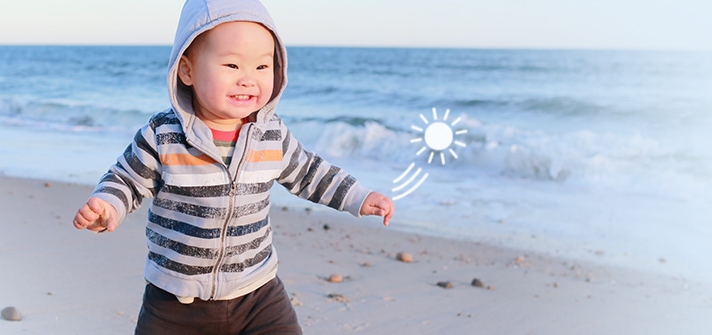























Magical milestones and physical play
Looking at your child now, it’s hard to imagine the tiny new born you brought home from the hospital who did little more than feed, sleep, and fill diapers. He’s come a long way and his second year will be an exciting time of developmental firsts. Get ready to be amazed by new skills that will have you beaming with pride (and reaching for your camera!)

Staying active, staying healthy
As your baby meets new physical milestones, he’ll be capable of taking part in lots more activities. Staying active as a toddler establishes a pattern for life-long activity, which contributes to his healthy growth. One exciting aspect of his strength, balance, and agility improving is that it means more play! Indeed, once he’s on the move, you may find you’re moving a lot more too, keeping up with him. If he’s already walking, then running won’t be far off.
Play brings fun and laughter, but also lots of benefits. It helps stimulate brain development, introduces toddlers to problem-solving, allows them to interact with others, and develops confidence. Blocks and soft toys, for example, can help to develop fine motor skills and hand-eye coordination.
Giving him plenty of opportunities to play is very important. Experts recommend a minimum of one to three hours of activity each day, including both structured and unstructured, or free, play. This doesn’t have to happen all at once, so short play sessions throughout the day are okay. Remember that this is the minimum amount of time. Most toys can be part of both structured and unstructured play, depending on how they are used.
Structured play: You, or another adult, decide what games your little one will play, or which toys he’ll interact with.
Benefits: Your support allows your toddler to do things he can’t do on his own. He learns by your example.
Examples: singing ‘action’ songs, copying games and puzzles, toddler classes such as music; and, when developmentally appropriate, team games such as soccer or gymnastics.
Free play: Your toddler sets the agenda for unstructured play, but you may still need to put some toys out for him to choose from. He’ll make up the game as he goes. Benefits: Allows your toddler to explore, imagine, and be creative.
Examples: pretend play, dressing up, playing in water or sand, playground play (slides, swings, tunnels, climbing etc).
Firsts in the second year
During his first 12 months, your baby may have tripled his birth weight. Over the next year, physical growth begins to slow down. He may only gain 1.5-2.5kg (3-5lbs) between his first and second birthdays. Although his growth may have slowed, his brain is busy developing lots of new skills, including walking and talking.
First steps: If your toddler’s not already walking, chances are he will be soon. Those much-celebrated first steps will be unsteady at first so be prepared for a few trips and tumbles. He’ll gradually become more confident.
Help him out: Once he can walk, encourage him to walk with you as much as possible. It will slow you down but it’s a great way for you both to get some exercise. Enjoy playing lots more physical games with him, now that he’s up on his feet.
First “conversation”: Even if he doesn’t talk back yet, your little one can understand much of what you say to him. He will learn the meanings of words from you before he can say them. Following your instructions is another matter! During his first year he loved the sounds of baby talk but now it’s time to move on.
Help him out: Use simple words, speak slowly, and repeat phrases. He’s learning language skills from you and other caregivers so talk, talk, talk. Repeat words at mealtimes, such as “more” and “done” to equip him with the language he needs to let you know when he’s hungry or full.
First “mini-me” moment: You are your toddler’s role model for everything he says and does.
Help him out: Dance, or move around, and enjoy watching him try to copy you. Hold up your hand for a “high-five” and he may actively hit it. Say a word over and over, and he may try to say it too. This can be great fun—just watch out for any words or actions you’d rather he didn’t adopt!
Don’t worry if your toddler hasn’t quite reached these milestones yet—all babies are unique and develop at their own pace. If you’re concerned, speak to your healthcare provider.
Sources
▪ Ertem IO, Krishnamurthy V, Mulaudzi MC, et al. Similarities and differences in child development from birth to age 3 years by sex and across four countries: a cross-sectional, observational study. Lancet Glob Health 2018; 6(3):e279-91.
▪ Okely AD, Ghersi D, Hesketh KD, et al. A collaborative approach to adopting/adapting guidelines – The Australian 24hour movement guidelines for the early years (birth to 5 years): an integration of physical activity, sedentary behavior, and sleep. BMC Public Health 2017; 17(Supple 5):869. doi: 10.1186/s12889-017-4867-6.
▪ Shelov SP & Altmann TR (Eds.). (2009). American Academy of Pediatrics. The complete and authoritative guide Caring for your baby and young child birth to age 5 (5th ed.). USA: Bantam Books.
▪ Society of Health and Physical Educators (SHAPE). Active start: A statement of physical activity guidelines for children from birth to age 5. 2nd ed. Reston, VA: SHAPE America; 2009. Available at: https://www.shapeamerica.org/standards/guidelines/activestart.aspx (Accessed August 8 2018)
▪ Tremblay MS, Chaput J, Adamo KB, et al. Canadian 24-hour Movement Guidelines for the Early Years (0-4 years): An integration of physical activity, sedentary behaviour, and sleep. BMC Public Health 2017; 17(Suppl 5):874 doi 10.1186/s12889-017-4859-6. https://pathways.org/growth-development/toddler/milestones/ (Accessed August 8 2018) https://pathways.org/topics-of-development/play/ (Accessed August 8 2018) https://pathways.org/watch/parents-guide-structured-vs-unstructured-play/ (Accessed August 8 2018)
Share With:
Recommended Articles

Romesh Jayasinghe
Understanding early childhood developmental psychology
Psychology is the study of human behavior and child psychology is the applied branch of psychology that studies both the normal and abnormal development and...
Read More
Tour of the world’s sleeping toddlers
“How do I get my toddler to sleep?” is an age-old, universally asked question. Find out how other parents are doing it across the globe. Sleep styles can...
Read More
Could screen time increase the chances of my toddler becoming overweight?
Did you know? Young children risk missing out on important outdoor play and activity when their time is spent watching television and in front of screens. ...
Read More